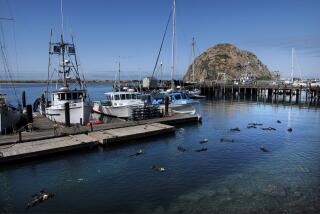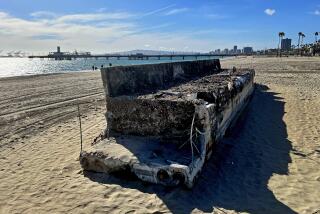Oil in Sand May Keep Beaches Shut
HUNTINGTON BEACH — Just when it appeared that efforts to mop up the Orange County oil spill were winding down, authorities feared Wednesday that a thin vein of crude may have seeped into the sand along a broad stretch of shoreline, threatening to indefinitely delay the opening of beaches.
If tests find oil lurking in more than a few isolated pockets in Huntington Beach and Newport Beach, officials say they would be forced to rev up the cleanup and possibly call in heavy equipment to tackle the oil-tainted sand, a process that could take weeks.
Kim McCleneghan, the state Department of Fish and Game’s oil-spill coordinator, said the oily residue runs along about 10 miles of shoreline from Bolsa Chica State Beach to Newport Beach, in some spots 10 to 20 feet wide.
“In some areas it is heavier than others,” McCleneghan said. “In the sand you can feel it, you can smell it.”
Authorities speculated that heavy rain, strong winds and pounding waves from a fierce storm that lashed the Southland last weekend may have driven oil that had washed ashore as much as a foot deep into the sand above the high tide line.
“I suspect this will delay the opening of the beaches,” said Petty Officer Tim Rowe of the U.S. Coast Guard. “The beaches look very good on the surface. But right now we have to figure out what to do with the stuff underneath.”
Work crews began in earnest Wednesday taking samples along a six-mile stretch of coastline from the Huntington Beach pier to just south of the Newport Pier.
Officials with British Petroleum, the firm that owned the 394,000 gallons of Alaskan crude that spilled Feb. 7 off Huntington Beach when the tanker American Trader punctured its hull with an anchor, said workers were digging into the sand at periodic points along the shoreline to determine the extent of the spread.
Chuck Webster, the firm’s crisis manager, said British Petroleum has “always felt we would find areas in which some subsurface penetration of oil had occurred. There is now evidence that the storm may have resulted in a larger penetration zone than initially recognized.”
Officials with the state Department of Fish and Game will review the results from the survey of the sand and decide how to tackle the problem after consulting with representatives of local cities, the Coast Guard and the oil company.
In past days, authorities have found oil “from an inch down to four inches, a fairly significant amount of concentrated oil,” said Curt Taucher, a state Fish and Game Department spokesman. Last week, Fish and Game officials found oil at a depth of 15 inches, he said. In most places the ribbon of oil has been less than an inch thick.
Taucher said teams from the agency at first “were under the impression the beaches were being cleaned up satisfactorily” but found in recent days there were still significant concentrations of oil when they surveyed the area.
Among the options being weighed by officials is employing a tractor and disk to plow up the crude so it can be removed by work crews or allowed to break down and evaporate in the sunlight. Authorities are also considering whether to try using a machine that normally picks up beach debris to sift the oil-tainted sand.
McCleneghan also said that hundreds of workers wielding shovels would dig up some sections of oil-stained sand, put it in bags and have it trucked away.
But they appeared to have ruled out employing bulldozers to dig up large sections of sand and cart it off. McCleneghan said officials want to “minimize the amount of sand removed from the beaches.”
For all the cleanup efforts, “there are limitations,” McCleneghan said. “We can’t get all the oil off the sand. . . . It won’t be gone. We’re not going to physically pick up and carry away” all the sand.
But, he said, “we’re going to try” to clean up enough oil “so you won’t be able to pick up a handful of sand and say this feels oily, this looks oily, this smells oily.”
McCleneghan said he could not estimate when the cleanup could be finished. “It’s not going to be months,” he said. “In some areas, it could be a matter of weeks.”
Webster said it is unclear how long a stretch of beach contains the layer of oil, which mixes with sand to look like brown sugar. But the firm remains ready to do whatever is necessary to clean the beach, he said.
“The last thing we want to see are the beaches reopened, kids out there playing with sandcastles and coming across oil,” Webster said.
Some local city officials, meanwhile, were calling on British Petroleum to conduct toxicity tests to ensure that the beach will be safe when the weather turns warm and crowds begin to hit the sand.
“I want to have chemical analysis done every quarter or half mile to see if there’s any contamination,” Huntington Beach Mayor Thomas J. Mays said. “When I open that beach, I want to make sure its safe for people to walk on.”
Mays said he suspected all along that oil had seeped below the surface of the beach, noting how he watched high winds from the weekend storm spread sand drifts over sections of shoreline already covered with crude.
Other local officials said they were pleased that British Petroleum was making efforts to unearth any oil that may have percolated into the sand.
“We are happy they are testing because we have been suspicious about the possibility of seepage,” said Newport Beach City Manager Robert L. Wynn. “We suggested to BP in our meetings with them that they test for this.”
Fish and Game marine biologist Ken Wilson was one of several experts who has run across pockets of oil deep in the sand, but closer to the surf line.
While digging for grunion eggs last week at Bolsa Chica State Beach, Wilson found “thin layers of what appeared to be oil-soaked sand” about four inches below the surface. About 5 or 6 inches down the biologist discovered an inch-thick layer of sand saturated “very heavily with oil.”
“It wasn’t gooey but you could definitely see the sand grain was discolored to a brown,” he said.
The layer of ooze could pose problems for the environment. Any grunion eggs would probably die as the oil permeated them, Wilson said. On rock jetties blackened by oil, numerous organisms risk being fouled by the crude, including barnacles, algae and various sea creatures.
But the spill has had its most visible impact on birds. By Wednesday afternoon, 446 birds had been found covered with oil but alive, while 370 have died because of the spill.
Meanwhile, work crews on Wednesday began cleaning rocky jetties stained by the crude.
Armed with equipment shipped from Alaska, where it had been used on the Exxon Valdez spill, workers sprayed a warm rinse of seawater to wash down rocky stretches of shoreline on Newport Beach and Bolsa Chica State Beach.
About 350 people participated in the cleanup Wednesday along beaches stretching from Bolsa Chica south to Newport Beach.
Staff writer Dan Weikel contributed to this report.
More to Read
Sign up for Essential California
The most important California stories and recommendations in your inbox every morning.
You may occasionally receive promotional content from the Los Angeles Times.










